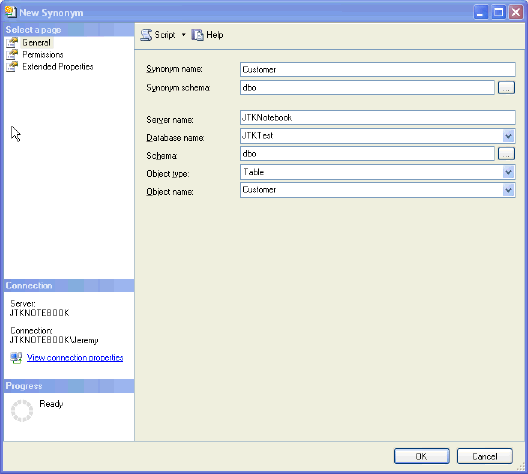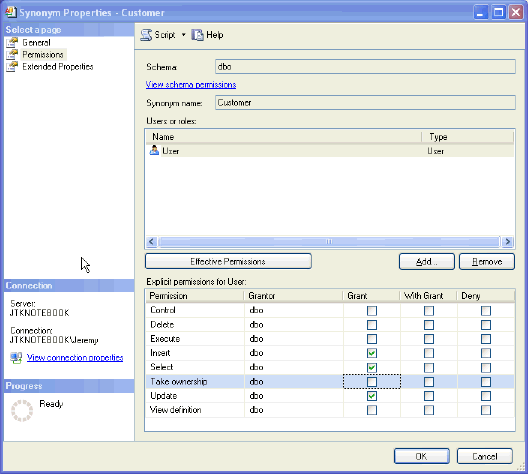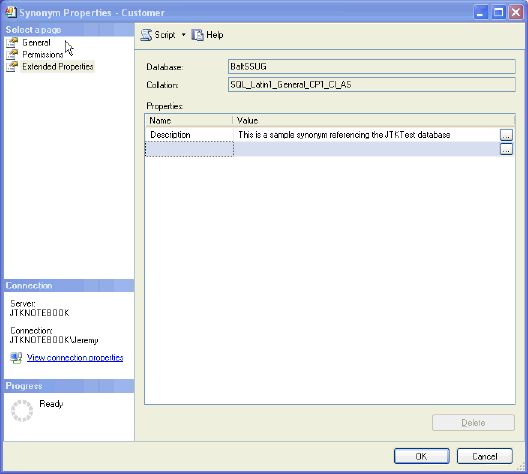By: Jeremy Kadlec | Comments (5) | Related: > Synonyms
Problem
Changing the name of an table once an application has been deployed has traditionally been a difficult task in SQL Server 2000. The typical solution in SQL Server 2000 for referencing a different object was to use a View. A second option was to use the sp_rename system stored procedure to rename objects as needed. Unfortunately, this limits the capabilities of referencing other objects. The need to be able to reference another object can become critical during system migrations, application testing, data corruption, etc. Does SQL Server 2005 handle this in a more elegant manner and support more than just tables?
Solution
SQL Server 2005 has introduced synonyms which enables the reference of another object (View, Table, Stored Procedure or Function) potentially on a different server, database or schema in your environment. In short, this means that the original object that is referenced in all of your code is really using a completely different underlying object, but no coding changes are necessary. Think of this as an alias as a means to simplify migrations and application testing without the need to make any dependent coding changes.
How do I create a synonym via SQL Server 2005 Management Studio?
| ID | Directions | Screen Shot |
| 1 | Launch GUI - To access the synonym interface navigate to SQL Server 2005 Management Studio | Server Name | Databases | Database Name | Synonyms | Right click on the Synonyms folder | New Synonym... | Not applicable |
| 2 | General Tab - Complete the Synonym name which should be a new name in the schema followed by the information for the aliased object |  |
| 3 | Permission Tab - Click the 'Add' button to grant rights to the synonym for specific database users |  |
| 4 | Extended Properties Tab - Add any extended properties for documentation purposes
For more information visit - Using Extended Properties on Database Objects |
 |
How do I create a synonym via T-SQL?
[UserDefinedDatabase]USE
GO
CREATE SYNONYM [dbo].[Customer]
FOR [JTKNotebook].[JTKTest].[dbo].[Customer]
GO
EXEC sys.sp_addextendedproperty @name=N'Description', @value=N'This is a sample synonym referencing the JTKTest database' , @level0type=N'SCHEMA',@level0name=N'dbo', @level1type=N'SYNONYM',@level1name=N'Customer'
How can I verify the statements issued against the synonym are affecting the base object?
Issue an INSERT statement against the synonym:
INSERT
INTO [BaltSSUG].[dbo].[Customer]
([CustID] ,[CustName] ,[CustAddress] ,[CustCity] ,[CustState] ,[CustZipCode])
VALUES (99 ,'DBA Dave' ,'123 Main Street' ,'Warren' ,'OH' ,12345)Issue a SELECT statement on the synonym:
SELECT
*
FROM [BaltSSUG].[dbo].[Customer]1 AAA 123 Main Washington DC 11111
2 BBB 456 Main New York NY 22222
3 CCC 789 Main St. Louis MO 33333
4 DDD 123 Maple Denver CO 44444
5 EEE 456 Maple San Fran CA 55555
99 DBA Dave 123 Main Street Warren OH 12345
Can I still issue statements against the base object?
Issue an INSERT statement against the base table:
INSERT
INTO [JTKTest].[dbo].[Customer]
([CustID] ,[CustName] ,[CustAddress] ,[CustCity] ,[CustState] ,[CustZipCode])
VALUES (100 ,'Developer Donna' ,'456 Main Street' ,'Chicago' ,'IL' ,67890)Issue a SELECT statement on the base table:
SELECT
*
FROM [JTKTest].[dbo].[Customer]1 AAA 123 Main Washington DC 11111
2 BBB 456 Main New York NY 22222
3 CCC 789 Main St. Louis MO 33333
4 DDD 123 Maple Denver CO 44444
5 EEE 456 Maple San Fran CA 55555
99 DBA Dave 123 Main Street Warren OH 12345
100 Developer Donna 456 Main Street Chicago IL 67890
Next Steps
- As you begin to migrate to SQL Server 2005 consider synonyms as a means to alias objects in your environment without the need to change the dependent code.
- The next time you need to make significant code changes due to application testing or a system migration and you are concerned about the level of effort to support the changes, first test the synonym functionality to determine if this will streamline the process and save time.
- Do not limit yourself to uses for the synonyms, consider other applications such as in data warehousing when managing fact tables.
- Check out our recent testing related tips:
About the author
 Jeremy Kadlec is a Co-Founder, Editor and Author at MSSQLTips.com with more than 300 contributions. He is also the CTO @ Edgewood Solutions and a six-time SQL Server MVP. Jeremy brings 20+ years of SQL Server DBA and Developer experience to the community after earning a bachelor's degree from SSU and master's from UMBC.
Jeremy Kadlec is a Co-Founder, Editor and Author at MSSQLTips.com with more than 300 contributions. He is also the CTO @ Edgewood Solutions and a six-time SQL Server MVP. Jeremy brings 20+ years of SQL Server DBA and Developer experience to the community after earning a bachelor's degree from SSU and master's from UMBC.This author pledges the content of this article is based on professional experience and not AI generated.
View all my tips






